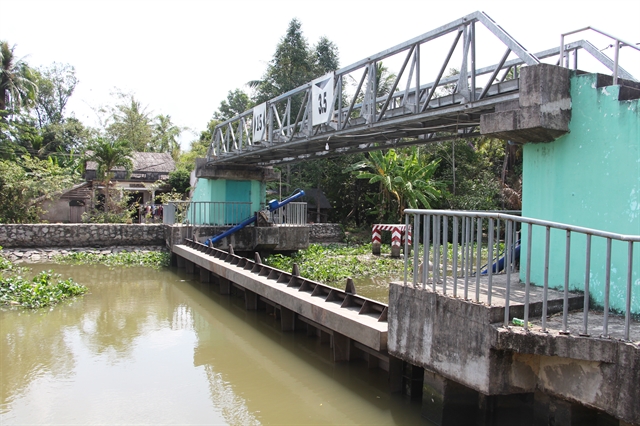 Environment
Environment

Saltwater intrusion in the Cửu Long (Mekong) Delta in the 2020 – 21 dry season is expected to be higher than average, but not as severe as the last dry season.

|
| A saltwater-prevention sluice in Vị Thanh City in the Cửu Long (Mekong) Delta province of Hậu Giang. – VNA/VNS Photo Hồng Thái |
HCM CITY – Saltwater intrusion in the Cửu Long (Mekong) Delta in the 2020 – 21 dry season is expected to be higher than average, but not as severe as the last dry season.
Phùng Tiến Dũng, head of the National Centre for Hydro-Meteorology Forecasting’s Hydro-Meteorology Forecasting Division for the Central, Tây Nguyên (Central Highlands) and South regions, said the delta would face the highest level of saltwater via the Mekong River in February and March.
The Vàm Cỏ and Cái Lớn rivers, which are the major rivers in the delta, are expected to face the highest level of saltwater waves in March and April, he said.
Saltwater intrusion in the delta, which depends on the water level from the upper areas of the Mekong River and high tides, will see changes in the future.
“Localities in the southern region should keep up-to-date information about hydro-meteorology forecasts and have measures to prevent and control saltwater intrusion,” he said.
There will be little rain in the upper areas of the Mekong River and the Southern region on January 6 – 11, according to the Hydro-Meteorology Forecasting Division.
The water levels at monitoring stations on the Mekong River in the delta will change slowly, and will be 0.1 – 0.2 metres lower than the average of many years.
From January 6 – 10, water with a saline content of 1 gramme per litre is expected to enter 35 – 50 km deep into the mouths of the delta’s main rivers.
During the period, water with saline content of 4 grammes per litre could enter 25 – 40 km deep into the mouths of the delta’s main rivers.
For instance, water with saline content of 4 grammes per litre could enter 35 – 40 km deep into the mouths of the Vàm Cỏ Đông and Vàm Cỏ Tây, Hậu and Cổ Chiên rivers, and 25 – 32 km deep into the mouth of the Cái Lớn River.
Most crops can only tolerate saltwater intrusion with a saline content of 1 gramme per litre.
The delta, the country’s largest producer of rice, fruit and seafood, has faced severe saltwater intrusion in recent years. Before and during the dry season, local authorities have taken measures to mitigate its impact on agricultural production and the lives of locals.
In recent years, the delta, which includes Cần Thơ City and 12 provinces, has built or upgraded saltwater prevention sluices and dams, dredged canals and irrigation works to store more fresh water, and instructed farmers to store irrigation water in ponds and other water containers for use in the dry season.
It has also restructured growing schedules of rice crops such as starting rice crops earlier than the normal schedule or switching to other drought-resistant crops in saltwater-affected areas in the dry season, in order to avoid a shortage of irrigation water.
The delta has also built or upgraded water supply facilities to ensure water supplies for households in saltwater-affected areas.
For the 2020 -21 dry season, local authorities have determined that if there is a severe shortage of fresh water in the dry season, water priority will be given to household use, animal husbandry, and high-value crops. – VNS